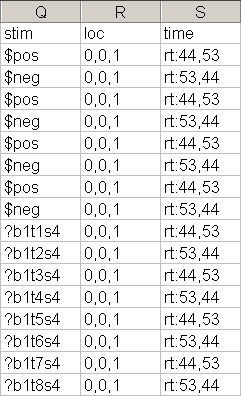Location:
…\DirectRT\samples\5- other features\10 using previous stim
Sample Description
In special cases you might want to instruct DirectRT to use a stimulus from a previous trial without knowing exactly what that stimulus will be when you design your input file. This could happen, for example, when a stimulus is randomly determined on one trial but then you want to repeat that trial. On the later trial you can simply tell DirectRT which stimulus you want to repeat. You are essentially saying, "use the third stimulus from block 2, trial 5--whatever it was!" To do so, you can use the "?" operator which means to use a previous stimulus, no matter whether it was randomly chosen or not. To refer to a previous stimulus, you just need to know the block (b), trial (t) and stimulus (s) IDs. For example if you want to use block 1, trial 3, stimulus 4 in a later trial, you would request: "?b1t3s4" in the stim column.
The sample input file "priming.csv" included in this folder illustrates this feature. Try running it. Notice the prime-target pairings used in the first 8 trials-the pairings are randomly chosen. Then watch the next 8 trials. The order of the trials is randomized-but the pairings are the SAME as they were in the first 8 trials!
How was this accomplished?
In this sample, primes and targets for the first 8 trials are all randomly selected without replacement from a stimlist. That's nothing unusual if you've been looking through the many priming samples. What's new is that we want to repeat this block of trials again with the same prime target combinations. The graphic below shows the targets which are the 4th stimulus on each trial. On the first 8 trials, you can see that they are randomly selected from a stim list (i.e., $pos and $neg). The next 8 trials use the "?" operator to find out what the previous targets were and inserts them. For example, on the 9th trial, the Stim column reads "?b1t1s4" --this means show the 4th stimulus from Block 1, Trial 1. We don't show it here, but the prime on this trial reads "?b1t1s2" which means to show the 2nd stimulus from Block 1, Trial 1. This results in Block 2, Trial 1 being identical to Block 1, Trial 1. Using block-specific RWG values, each block is randomized separately. Voila! We're done.
